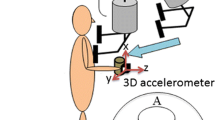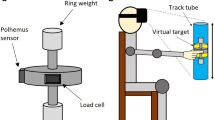Abstract
The aim of this study was to determine time-of-day variations of grip force control during a manipulative task. In particular, we repeatedly tested continuous up and down movements of a hand held instrumented object on two consecutive days. The movements caused fluctuations in the load that had to be compensated for by adequate grip forces. The level of grip force, the acceleration of the arm movement, the ratio of grip and load force as well as the temporal relationship between the two force profiles and the subjective sleepiness were examined. The time-of-day protocol lasted 26 h with sessions at different times of day, and sleep at night. Diurnal variations were analyzed with an intersession interval of 2 h; detailed analyses were carried out for the evening sessions until bed time and the sessions in the morning after awake. The present study proves a time-of-day effect for the level of grip force as well as for the acceleration. The effect was most obvious during the morning sessions when both parameters increased. The ratio of grip force to load, i.e., independent of the actual load and acceleration, shows a similar modulation as grip force. This later finding suggests that grip force changed partly independently from changes of arm acceleration. Time of day did not influence the strength of the cross-correlation and the synchronicity between the two force profiles. Thus, while grip force changed with time of day, the predictive coupling of the grip force according to the load was constant.





Similar content being viewed by others
References
Akerstedt T, Gillberg M (1990) Subjective and objective sleepiness in the active individual. Int J Neurosci 52:29–37
Atkinson G, Coldwells A, Reilly T, Waterhouse J (1993) A comparison of circadian rhythms in work performance between physically active and inactive subjects. Ergonomics 36:273–281
Blatter K, Cajochen C (2007) Circadian rhythms in cognitive performance: methodological constraints, protocols, theoretical underpinnings. Physiol Behav 90:196–208
Dosseville F, Moussay S, Larue J, Gauthier A, Davenne D (2002) Physical exercise and time of day: influences on spontaneous motor tempo. Percept Mot Skills 95:965–972
Ferrara M, De Gennaro L (2000) The sleep inertia phenomenon during the sleep–wake transition: theoretical and operational issues. Aviat Space Environ Med 71:843–848
Flanagan JR, Johansson RS (2002) Hand movements. In: Ramshandran VS (ed) Encyclopedia of the human brain. Academic, San Diego, pp 399–414
Flanagan JR, Tresilian JR (1994) Grip-load force coupling: a general control strategy for transporting objects. J Exp Psychol Hum Percept Perform 20:944–957
Flanagan JR, Wing AM (1993) Modulation of grip force with load force during point-to-point arm movements. Exp Brain Res 95:131–143
Flanagan JR, Wing AM (1995) The stability of precision grip forces during cyclic arm movements with a hand-held load. Exp Brain Res 105:455–464
Flanagan JR, Wing AM (1997) The role of internal models in motion planning and control: evidence from grip force adjustments during movements of hand-held loads. J Neurosci 17:1519–1528
Flanagan JR, Tresilian J, Wing AM (1993) Coupling of grip force and load force during arm movements with grasped objects. Neurosci Lett 152:53–56
Gaba DM, Howard SK (2002) Patient safety: fatigue among clinicians and the safety of patients. N Engl J Med 347:1249–1255
Hermsdörfer J, Marquardt C, Philipp J, Zierdt A, Nowak D, Glasauer S, Mai N (2000) Moving weightless objects. Grip force control during microgravity. Exp Brain Res 132:52–64
Hermsdörfer J, Hagl E, Nowak DA, Marquardt C (2003) Grip force control during object manipulation in cerebral stroke. Clin Neurophysiol 114:915–929
Ilmarinen J, Ilmarinen R, Korhonen O, Nurminen M (1980) Circadian variation of physiological functions related to physical work capacity. Scand J Work Environ Health 6:112–122
Jeanneret P, Webb W (1963) Strenght of grip on arousal from full night’s sleep. Percept Mot Skills 17:759–761
Jewett ME, Wyatt JK, Ritz-De Cecco A, Khalsa SB, Dijk DJ, Czeisler CA (1999) Time course of sleep inertia dissipation in human performance and alertness. J Sleep Res 8:1–8
Johansson RS (1996) Sensory control of dexterous manipulation in humans. In: Wing A, Haggard P, Flanagan JR (eds) Hand and brain. Academic, San Diego, pp 381–414
Johansson RS, Westling G (1984) Roles of glabrous skin receptors and sensorimotor memory in automatic control of precision grip when lifting rougher or more slippery objects. Exp Brain Res 56:550–564
Kawato M, Kuroda T, Imamizu H, Nakano E, Miyauchi S, Yoshioka T (2003) Internal forward models in the cerebellum: fMRI study on grip force and load force coupling. Prog Brain Res 142:171–188
Kleitman N (1963) Sleep and wakefulness. University of Chicago Press, Chicago
Lawrie SM, MacHale SM, Cavanagh JT, O’Carroll RE, Goodwin GM (2000) The difference in patterns of motor and cognitive function in chronic fatigue syndrome and severe depressive illness. Psychol Med 30:433–442
Moussay S, Dosseville F, Gauthier A, Larue J, Sesboue B, Davenne D (2002) Circadian rhythms during cycling exercise and finger-tapping task. Chronobiol Int 19:1137–1149
Moussay S, Bessot N, Gauthier A, Larue J, Sesboue B, Davenne D (2003) Diurnal variations in cycling kinematics. Chronobiol Int 20:879–892
Nowak DA, Hermsdörfer J (2003) Digit cooling influences grasp efficiency during manipulative tasks. Eur J Appl Physiol 89:127–133
Pearson R, MacKinnon MJ, Meek AP, Myers DB, Palmer DG (1982) Diurnal and sequential grip functions in normal subjects and effects of temperature change and exercise of the forearm on grip function in patients with rheumatoid arthritis and in normal controls. Scand J Rheumatol 11:113–118
Roenneberg T, Wirz-Justice A, Merrow M (2003) Life between clocks: daily temporal patterns of human chronotypes. J Biol Rhythms 18:80–90
Stolz G, Aschoff JC, Born J, Aschoff J (1988) VEP, physiological and psychological circadian variations in humans. J Neurol 235:308–313
Strutton PH, Catley M, Davey NJ (2003) Stability of corticospinal excitability and grip force in intrinsic hand muscles in man over a 24 h period. Physiol Behav 79:679–682
Valdez P, Ramírez C, García A, Talamantes J, Armijo P, Borrani J (2005) Circadian rhythms in components of attention. Biol Rhythm Res 36:57–65
Wehr TA, Aeschbach D, Duncan WC Jr (2001) Evidence for a biological dawn and dusk in the human circadian timing system. J Physiol 535:937–951
Winget CM, DeRoshia CW, Holley DC (1985) Circadian rhythms and athletic performance. Med Sci Sports Exerc 17:498–516
Wright V (1959) Some observations on diurnal variation of grip. Clin Sci (Lond) 18:17–23
Acknowledgments
We wish to thank all subjects sincerely for their participation in the present study which included not only testing at 15 sessions but also maintaining a fixed sleep–wake schedule for 1 week. We also wish to express our sincere thanks to Prof. Anna Wirz-Justice, Prof. Christian Cajochen and Kurt Kräuchi for their support in preparing the protocol. Many thanks to Dr. Yong Li and Andreas Zierdt for their patient help to draw up the figures. This research is part of the Ladenburg Collegium “ClockWork” that is funded by the Gottlieb Daimler- and Karl Benz-Foundation.
Author information
Authors and Affiliations
Corresponding author
Rights and permissions
About this article
Cite this article
Jasper, I., Hermsdörfer, J. Time-of-day effects on force control during object manipulation. Eur J Appl Physiol 101, 437–444 (2007). https://doi.org/10.1007/s00421-007-0514-8
Accepted:
Published:
Issue Date:
DOI: https://doi.org/10.1007/s00421-007-0514-8




